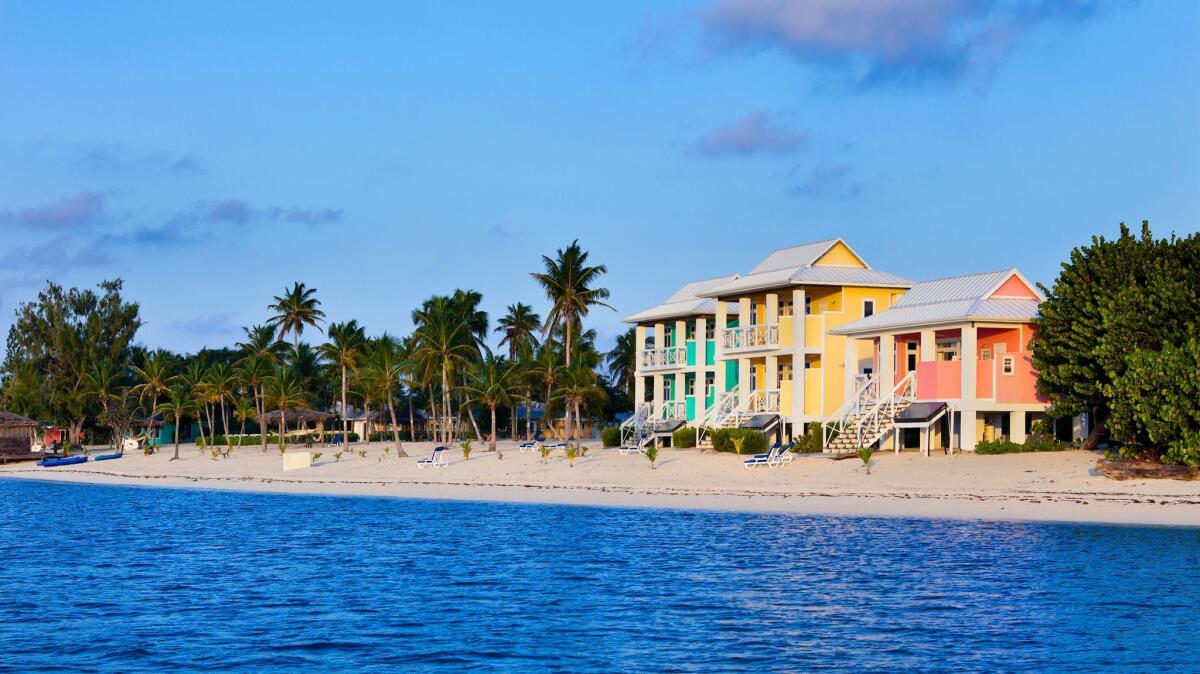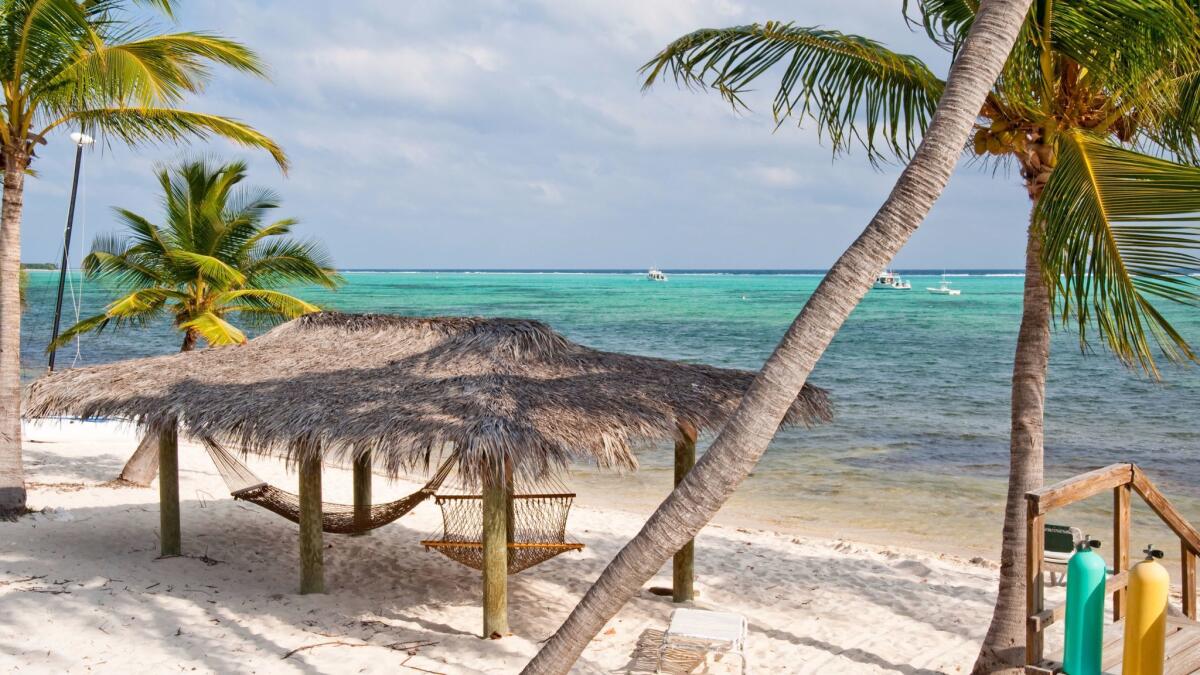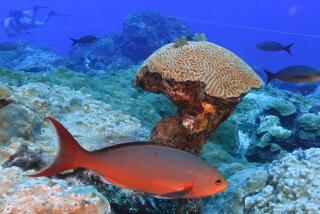A diver’s delight in the Cayman Islands
- Share via
Reporting from Grand Cayman — “Little,” as locals call the Caribbean’s Little Cayman, is a diminutive chunk of porous limestone 110 miles south of Cuba with a human population of about 150.
There are thousands more red-footed boobies, frigate birds and iguanas here than there are people.
Although it has lovely white-sand beaches, this 10- by 1-mile-wide islet is geographically boring, rising only several feet above sea level at its highest point.
It’s what’s offshore and under the waves — vibrant reefs, spectacular coral-covered walls and large swaths of no-fishing zones guaranteeing abundant marine life — that’s fascinating and attracts scuba enthusiasts from around the globe.
Nor does it hurt that visibility is often 100 feet or more.
Along with neighboring Cayman Brac, these so-called Sister Islands hold a special status among divers as some of the best places to view the undersea world, ranking with Palau in Micronesia and the Red Sea. The Brac, home to 1,500 people, is slightly more interesting geologically, thanks to a bluff that rises 140 feet at the eastern end of the island.
Some say the best time of year to dive here is May through October, although much of that period coincides with Atlantic hurricane season. The waves are usually calm then, and water temperatures rise to the low 80s, which means all you need is a thin shortie wet suit or a dive skin to protect from brushes with stinging fire coral.

My trip started on Grand Cayman, population 53,000. It’s the main outpost in the three-island group best known for its offshore banking industry. It’s also a frequent stop for huge cruise ships.
Because I had time between flights, I caught a ride into George Town, the capital, to check out an exhibit on the history of diving at the National Museum on Harbour Drive.
It featured some of the earliest equipment, including underwater photography gear and a chain-mail suit for diving with sharks, a sport launched by Jacques Cousteau in the 1940s.
There was even a double-hose regulator on display, similar to one I had purchased after passing my scuba certification course in 1968.
Then it was off to the Brac, 90 miles northeast, on a small Cayman Airways prop plane that held about a dozen passengers and featured a brightly painted sea turtle on its side.
Within several hours of landing, I was on a Reef Divers boat listening to a briefing about Anchor Wall, my first dive of the trip.
Floating in ‘inner space’
After the help of a quirky, tattooed English dive master who double-checked my tank to see whether I had adequate air, I took a breath from my regulator, held onto my mask and did a giant stride into the drink off the back of the boat.
I equalized the pressure in my ears as I sank about 85 feet to a coral garden and into what some divers like to call “inner space.”
All around me were huge barrel sponges, smaller yellow tube sponges, sea fans, purple whip Gorgonians and giant brain corals.
That list didn’t even begin to include the friendly groupers, multi-hued parrotfish, spotted scorpionfish and barracudas, as well as stingrays we found semi-hidden in the sand and a hawksbill turtle that was oblivious to our presence.
The Englishman tapped on his tank with a piece of metal and my group, which included a couple from San Francisco and a pair of Canadians, followed him to the edge of a wall that dropped away, seemingly into infinity.
We swam along the wall for 30 minutes, then returned to get a closer look at the huge anchor stuck in the coral from some long-forgotten ship.
After dinner that evening at the Cayman Brac Beach Resort, which features a pool, a Reef Divers shop, a bar and a restaurant, we headed out for a night dive. We saw another assortment of marine life that included moray eels, lobsters, basket stars, bright-orange clown crabs and an iridescent, shape-shifting octopus that inched along the coral.
The next morning, we dived on the Capt. Keith Tibbetts, a 330-foot-long Russian frigate that had been sunk to create an artificial reef.
Now crusted with coral and broken in half by storms, it rests on white sand about 100 feet below the surface.
As we swam through the innards of the ship, we were joined by a large grouper that was hoping for a handout. Nassau groupers, curious by nature, have become accustomed to feasting on diver-speared lionfish.
These voracious, long-spined creatures, although lovely to see, aren’t native to the Caribbean and are wreaking havoc on sea life because they have no predators and reproduce like aquatic rabbits.
For nondivers or those who would like a break from the water, the 12- by 2-mile island has a spectacular 140-foot bluff at the eastern end that plunges into the sea. (The island takes its name from this cliff: “Brac” is Gaelic for bluff.)
There are also caves for spelunking, rock walls for climbing, hiking paths, fishing boats for hire and several museums that cover the flora, fauna and human history of the island.
Next stop on my outing was Little Cayman, where I met up with photographer Jim Koetting, with whom I’d last dived on the Yukon, a 300-foot Canadian destroyer sunk (on purpose) off San Diego in 2000.
Corner of the Caribbean

Little Cayman Beach Resort, on the eastern end of the island, offers a spa and tennis courts, plus bikes for rent. The resort has 40 comfortable rooms, a pool, a dive shop and an outdoor bar and restaurant that serve delicious meals, many of them featuring seafood.
It’s also a short walk from Booby Pond, home to nearly 100 species of shorebirds, seabirds, waders and birds of prey best viewed from an elevated platform that is part of the island museum.
On our first dive, we quickly became buddies with Romel Ramon, an amiable dive master from Honduras. Over the next few days, he led us to sites such as Bloody Bay Wall and Jackson’s Bite, through coral tunnels and to sand patches where we saw numerous rays that tolerated our presence.
“This is truly a great corner of the Caribbean to dive, mon,” he said with a grin. “Especially since it’s a bit off the beaten path.”
Jason Belport, a La Jolla native who manages the resort, grew up diving in Southern California’s often chilly waters.
“I love California’s kelp beds, but it’s hard to beat the warm water, coral and marine life here,” said Belport, who has lived in the Caribbean for 20 years. “Mother Nature has blessed us here.”
One evening, while returning from a night dive, we turned off all but the dimmest running lights on the boat and gazed into the heavens.
The closest city was 90 miles away and the moon had not yet risen, so the sky was completely black except for thousands of individual stars that graced the firmament, to say nothing of the truly milky Milky Way.
If you go
THE BEST WAY TO GEORGE TOWN, CAYMAN ISLANDS
From LAX, American, United, Jet Blue and Delta offer connecting service (change of planes) to George Town. Restricted round-trip fares from $636, including taxes and fees.
A week of diving with Reef Divers at Little Cayman Beach Resort or Cayman Brac Beach Resort begins at about $1,500, including lodging, all meals and guide services. Five-day packages are also available. The other dive operator on Little Cayman is the Southern Cross Club; Cayman Brac has the Brac Scuba Shack.
TO LEARN MORE
More to Read
Sign up for The Wild
We’ll help you find the best places to hike, bike and run, as well as the perfect silent spots for meditation and yoga.
You may occasionally receive promotional content from the Los Angeles Times.






